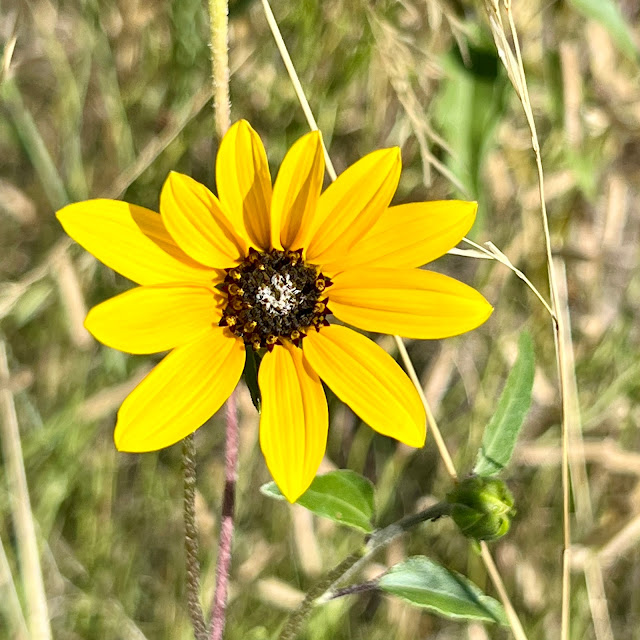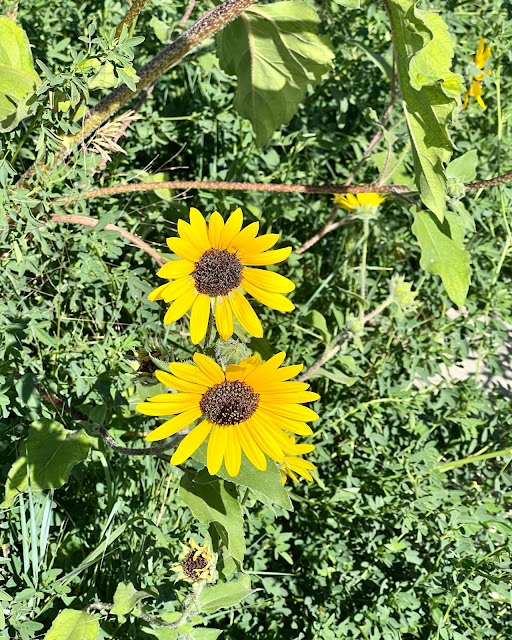Whenever I'm "home" in Smith's Cove, Nova Scotia,
I make a point of attending a meeting of the Smith's Cove rug hookers.
The meetings are held on Tuesdays from 10:00 am - 2:00 pm
at the Smith’s Cove Old Temperance Hall Museum.
My sisters Donnie, Barb, and Bertie are among the talented hookers in the area
who gather to hook, share their skills, talk, and enjoy coffee and treats.
I love attending because I feel connected to generations of hookers in my family
back to my great grandmother Sara Augusta (Cossett) Cossaboom and beyond.
A Meeting of the Smith's Cove Rug Hookers
Smith’s Cove Old Temperance Hall Museum
Smith's Cove, Nova Scotia, Canada
August 1, 2023
© M. Louise (MacBeath) Barbour/Fundy Blue
All Rights Reserved
Smith’s Cove Old Temperance Hall Museum
Smith's Cove, Nova Scotia, Canada
August 4, 2015
© M. Louise (MacBeath) Barbour/Fundy Blue
All Rights Reserved
Claire MacDonald began the hooking group in Smith's Cove in September 1994.
She taught many of the members of the group to hook, and
numerous pieces resulted because of her knowledge, patience, and guidance.
Some of these beautiful fabric art pieces are displayed in the museum today.
Smith’s Cove Old Temperance Hall Museum
Smith's Cove, Nova Scotia, Canada
August 4, 2015
© M. Louise (MacBeath) Barbour/Fundy Blue
All Rights Reserved
Smith’s Cove Old Temperance Hall Museum
Smith's Cove, Nova Scotia, Canada
August 4, 2015
© M. Louise (MacBeath) Barbour/Fundy Blue
All Rights Reserved
The origin of rug hooking is uncertain.
Certainly the craft of rug making is ancient and dates back as far as 2500 years.
Some historians credit Egypt with the origin of rug making; others, China or Europe.
Hooked rugs likely originated over 400 years ago in England,
and early settlers brought the craft to Canada and America.
What we do know is that rug hooking grew out of necessity in Atlantic Canada.
To provide warmth and color in the early settlers' homes,
worn clothing and bedding was repurposed into hooked rugs.
The fabric was cut into strips and hooked into burlap sourced from potato or feed sacks.
Local plants provided dyes, and wood, bones, cutlery, or nails provided hooks.
© M. Louise (MacBeath) Barbour/Fundy Blue
All Rights Reserved
A Vibrant Rug Hooked by Current Member Ida Young
August 1, 2023
© M. Louise (MacBeath) Barbour/Fundy Blue
All Rights Reserved
A new rug might be placed by the front door to keep out a cold draft.
As it wore down, it was moved to less and less prominent spots in the home.
Eventually, the rug was taken apart and the salvaged materials
were hooked into a new piece, perhaps another rug or a seat cover.
Today, while rug hooking techniques remain the same,
the craft has moved from utilitarian pieces to an art form.
Contemporary pieces are displayed in museums,
galleries, shops, businesses, and homes.
Smith’s Cove Old Temperance Hall Museum
Smith's Cove, Nova Scotia, Canada
August 4, 2015
© M. Louise (MacBeath) Barbour/Fundy Blue
All Rights Reserved
Everyday scenes often inspired designs for hooked rugs.
A sailboat in the Annapolis Basin.
Smith's Cove, Nova Scotia, Canada
August 2, 2015
© M. Louise (MacBeath) Barbour/Fundy Blue
All Rights Reserved
Inspiration for rug patterns or designs came from the daily lives of the rug hookers.
Those who lived along the coasts of Nova Scotia hooked designs containing
ships, waves, anchors, fish, sea birds, or favorite places on the shores.
Those who lived inland hooked animals, houses, churches, trees, flowers, and farms.
Hookers also drew on memories of their ancestral homelands
or created designs based on their cultures.
For example, French Acadians often worked floral patterns and scrolls into their rugs.
Today inspiration for rug designs can come from anywhere.
My great grandmother Sara Augusta (Cossett) Cossaboom
hooked many beautiful rugs during her lifetime.
She was born on August 21, 1873 in Smith's Cove,
and she died there on September 11, 1966 at the age of 93.
She married John Kelsey Cossaboom in the Cove on January 22, 1896,
and my grandmother Ella Grace (Cossaboom) MacDonald was born on February 20, 1897.
My great grandfather died in 1910, leaving Great Grammie with four young girls.
She managed to hook wonderful rugs in spite of her struggle
to raise her daughters alone and support herself.
Smith's Cove, Nova Scotia, Canada
Date Unknown
© M. Louise (MacBeath) Barbour/Fundy Blue
All Rights Reserved
I'm sharing two of her rugs that contain scenes and events
that her descendants continue to enjoy today:
the traditions continue with modern twists.
and Enjoying a Bonfire on the Beach
Donnie, Heather, and Justin
Smith's Cove, Nova Scotia, Canada
August 1, 2023
© M. Louise (MacBeath) Barbour/Fundy Blue
All Rights Reserved
Hooked by Sara Cossaboom in1920
© M. Louise (MacBeath) Barbour/Fundy Blue
All Rights Reserved
Sara Cossaboom Would Be Jackson's Great Great Great Grandmother
Point Prim, Nova Scotia, Canada
July 29, 2023
© M. Louise (MacBeath) Barbour/Fundy Blue
All Rights Reserved
My sister Roberta "Bertie" Anne (MacBeath) Heembrock
is another wonderful rug hooker in the family.
Bertie Hooking a Large Rug
Smith’s Cove Old Temperance Hall Museum
August 4, 2015
© M. Louise (MacBeath) Barbour/Fundy Blue
All Rights Reserved
Bertie at Work
Smith’s Cove Old Temperance Hall Museum
August 4, 2015
© M. Louise (MacBeath) Barbour/Fundy Blue
All Rights Reserved
Bertie hooked perhaps my favorite piece ever.
Her friend Sally Dansereau of Calgary created the design and Bertie hooked it.
It contains so many traditional Smith's Cove design elements:
the mountains, Digby Gut, Bear Island, and a sailboat on the Annapolis Basin.
But it also contains personal elements that mean so much to our family:
Our grandparents Ella and Jack MacDonald's home,
our grandfather's shop where he worked as a carpenter,
and the Bear River Lighthouse which members of our extended family
are helping the Smith's Cove Historical Society restore.
Grammie's home is surrounded by her climbing roses and apple trees
and Bertie's beautiful blue hydrangeas.
Most special is the tiny white dog with the red collar in the lower left, sweet Noodles,
the Heembrock family pet but known and loved by all of us, never forgotten.
Smith's Cove, Nova Scotia, Canada
August 4, 2015
© M. Louise (MacBeath) Barbour/Fundy Blue
All Rights Reserved
Terry in Front of the Bear River Lighthouse
Smith's Cove, Nova Scotia, Canada
July 27, 2023
© M. Louise (MacBeath) Barbour/Fundy Blue
All Rights Reserved
My talented sister Barbara "Barb" Ella MacBeath has had
at least one of her pieces displayed in the museum,
this still life of colorful spring flowers.
Barb is currently the treasurer of the Smith's Cove Historical Society,
one of eleven volunteers on the Board of Directors.
Barb (right) and I at a Fund Raiser for Digby's Museum
Digby, Nova Scotia, Canada
August 3, 2019
© M. Louise (MacBeath) Barbour/Fundy Blue
All Rights Reserved
My Sister Donnie and Other Members of the Smith Rug Hookers at Work
Old Temperance Hall Museum
August 4, 2015
© M. Louise (MacBeath) Barbour/Fundy Blue
All Rights Reserved
This next rug is bittersweet.
It was begun by our "Aunt" Mary Lou Raymond who was married
to our mother's first cousin, the famous Nova Scotian painter Kelsey Raymond.
Mary Lou was well known for her formidable knowledge of the area's history,
for her volunteer work at many events,
and for her excellent rug hooking skills.
She was a mainstay of the Smith's Cove Historical Society for many years.
If one of Mary Lou's hooked pieces was up for auction,
it was fiercely bid for by people who knew her and her work.
The last lines of hooking she completed are in the left side
of the vertical square dominating the photo below: blue, white, and green.
Members of the group are finishing her rug.
Last Stitches by a Skilled Hooker
Smith’s Cove Old Temperance Hall Museum
Smith's Cove, Nova Scotia, Canada
August 1, 2023
© M. Louise (MacBeath) Barbour/Fundy Blue
All Rights Reserved
When I visited in the summer of 2015, my sisters outfitted me
with everything I needed to become a rug hooker.
I had dreams of joining Smith's Cove's rug hooking group.
I was hopeless.
Too ADHD.
I had no patience for the meticulous work.
I returned everything to my sisters the following summer
with only a few more stitches completed.
But I go to the meetings when I can,
because the conversation and the memories are awesome!
Not for Me!
Smith's Cove, Nova Scotia, Canada
August 8, 2015
© M. Louise (MacBeath) Barbour/Fundy Blue
All Rights Reserved
Fortunately I won a lovely piece created by the rug hookers
at the museum in a fundraising raffle,
and it now graces my dining room table at home in Colorado.
Many of the hookers I know worked on this, including my sisters and Mary Lou.
It one of my most-treasured possessions.
A Familiar Theme ~ Sail Boats on the Basin
Aurora, Colorado, USA
August 22, 2023
© M. Louise (MacBeath) Barbour/Fundy Blue
All Rights Reserved
Sail Boats on the Basin with Bear Island to the Right
Smith's Cove, Nova Scotia, Canada
August 1, 2015
© M. Louise (MacBeath) Barbour/Fundy Blue
All Rights Reserved
My sister Sara Donalda "Donnie" MacBeath is also an inspiring Smith's Cove rug hooker.
She is currently the president of the Smith's Cove Historical Society.
Smith’s Cove Old Temperance Hall Museum
August 1, 2023
© M. Louise (MacBeath) Barbour/Fundy Blue
All Rights Reserved
If ever you visit Nova Scotia, stop at one of its many small museums,
sign the guest book, perhaps make a small donation, and take in the local culture.
Smith’s Cove Old Temperance Hall Museum is just one of many
throughout the province that function because of dedicated volunteers.
The number of people signing in at the museums can qualify
these local institutions for vital grants, funds, and summer employees.
If you're lucky you might come across a rug hooking group at work.
And I'll bet the members will welcome you, answer your questions,
and show you how this traditional craft is done.
They'll likely invite you to have a cup of coffee and some homemade goodies as well!
I'm linking to Rain's Thursday Art and Dinner Date and Nicole's Friday Face Off.
Brownies, Fruit, Muffins, Sandwiches, Biscuits, and Jam
Smith’s Cove Old Temperance Hall Museum
August 1, 2023
© M. Louise (MacBeath) Barbour/Fundy Blue
All Rights Reserved
Have a great weekend!
Sources of Information:
ProQuest.com Qualifying Paper: From the Kitchen Floor to the Gallery Wall by Rebecca Carr

































































